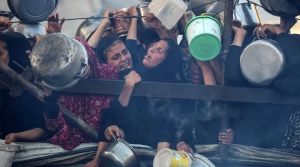During the 1948 War of Independence, Samson’s Foxes, an Israeli commando unit, fought on the southern front. The unit was named after the Biblical story of Samson, who avenged himself creatively on the Philistines:
“Samson caught 300 foxes. He turned them tail-to-tail and put a torch between each pair of tails. He lit the torches and turned them loose among the Philistines’ standing grain, setting fire to the standing grain and the stacked grain” (Judges 15:4-5).
Now – over 3,000 years after Samson avenged himself on the Philistines in Gaza using burning torches attached to foxes, and 70 years after the newly born State of Israel was defended by Samson’s Foxes – Gazans, the heirs to the Philistines, have adopted a new weapon: fire kites. They attach Molotov cocktails to colourful kites, fly them up over the border fence and use them to set fire to the grain growing in the fields of the Jewish farming communities bordering Gaza. How ironic.
Gazan weaponry seems to have devolved in recent years, moving from weapons such as rockets that the Iron Dome can intercept and render less effective, to underground attack tunnels, a system that has also been rendered less effective by Israeli ingenuity, to fire kites. If this trend continues, perhaps we will be faced with exploding marbles or commandos on children’s scooters in a few years.
READ: WE ARE NO LONGER YOUNG DAVID ASTRIDE GOLIATH
Faced with tens of thousands of Gazans in the Hamas-organized “March of Return” who are crying out in enmity and hate against Israel and trying to break through the border fence, one must strive to imagine what the Palestinians might achieve, were they to live side-by-side with Israel, instead of trying to destroy it.
Let us Israelis remind the world what our grandparents had to do when they arrived in this desolate, untamed land 100 years ago, without the assistance of UNRWA or other international aid groups. They laboured, drilled, spat blood, built and made the land bloom, step by painstaking step. At the same time, they extended their hand to their Arab neighbours, believing there was room for all and that it was possible to live here together.
Then imagine this: Gazans, under different leadership, decide to devote their energies and the aid they receive from around the world to build infrastructure and make Gaza bloom. Yes – that miserable, crowded place can blossom, if only there were the will to make it happen.
Imagine Gazans using their energy, passion and abilities to build their homes, rather than try to destroy Israeli houses. Israelis would be the first to come and help them, followed by the Jews of the Diaspora, then the rest of the Western world and finally the Arab world. Imagine the hotels, artificial islands, airports, sports facilities, free-trade zones, ports and entrepreneurial incubators. It could indeed be the Singapore of the Middle East. And why not: was draining the Yezreel Valley swamps, or bringing water to the Negev any easier?
Ecclesiastes Chapter 3 states: “To everything there is a season, and a time for every purpose under heaven.… A time to plant and a time to uproot.… A time to love and a time to hate. A time for war and a time for peace.”
Even in times of war, may we be wise, strong and kind enough not to hate our enemies. May we soon reach the time to plant and the time for peace. May there be a day when we will sit shoulder-to-shoulder and swap folk tales – from Samson’s foxes, to the kites of Gaza.
Author

Sagi Melamed is vice-president of external relations and development at the Max Stern Yezreel Valley College and president of the Harvard Club of Israel. He is the author of Son of My Land and Fundraising.
View all posts







